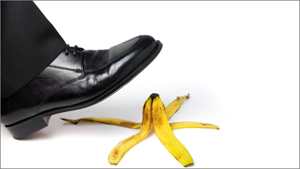Bananas: Chemists in Little Yellow Labcoats
by
 Until we perfect the teleporter, transporting fruit will always pose a problem – particularly when the transport involves thousands of miles. However, by elucidating the mechanisms of ripening for individual fruits, producers have developed reliable methods of transportation, which is why we can enjoy a banana split in the middle of winter.
Until we perfect the teleporter, transporting fruit will always pose a problem – particularly when the transport involves thousands of miles. However, by elucidating the mechanisms of ripening for individual fruits, producers have developed reliable methods of transportation, which is why we can enjoy a banana split in the middle of winter.
My normal grocery store routine involves picking up one large bunch of bananas to last me through the week. Since I’ve never been a huge fan of the green ones, what usually follows is a staring contest between myself and the bananas as I wait for them to ripen. It usually looks something like this: Day 1 – wait; Day 2 – wait; Day 3 – eat 8 bananas; Day 4 – throw out the leftover brown one.
As it turns out, not only is eating that many bananas in a short period of time difficult, it’s just plain dangerous. As bananas ripen, they convert starch to sugar. So much sugar in fact, that bananas have about twice the amount found in an average candybar. Some nutritionists actually recommend eating a banana in two halves, two hours apart, to reduce the dramatic increase in insulin levels.
So for the sake of avoiding a carbohydrate spike like Kobayashi’s after a trip to Coney Island, can we exploit the chemistry of ripening to better control the process?
Of course we can. (I can’t stump myself in my own post…)
As it turns out, the ripening process is regulated by the plant hormone ethylene. To ensure that bananas aren’t delivered as mushy black sticks, they are picked green and then ripened in ethylene chambers upon arrival at their destination. While it’s unlikely that we have our own ethylene chambers at home, it’s easy enough to make one. By throwing a ripe banana into a bag with a green one, the trapped ethylene will rapidly induce the ripening of the green banana. So by ripening one or two bananas at a time, we can avoid the 40% blood sugar that comes with a one-day banana-eating contest.
To better control the gaseous environment surrounding fresh produce, several companies are developing breathable polymer film technologies that carefully regulate the transmission of gases in and out of a package. By maintaining optimal gas exchange rates, particularly through the various temperatures encountered during transport, producers and distributors may dramatically extend the shelf life of produce.
So why do bananas in the freezer turn black so quickly? Are they ripened by the cold as well as ethylene?
Bananas are surprisingly complex and like everything else in the world, they are in a constant battle to fend off bacteria, insects, fungus, etc. As a result, they have developed an impressive chemical defense system. When the integrity of a banana is challenged by temperature, impact or other means, the damaged cells secrete polyphenols. Phenol oxidases convert the polyphenols to quinones, which ultimately lead to the generation of antifungal and insecticidal compounds known as melanins. As we know from skin pigments, melanins are dark and thus produce the dark skin we find on a frozen banana.
However, it’s always important to remember we are not bananas…so don’t sit in the freezer expecting to get that “just back from vacation” look…
For some great produce-related resources, check out the following sites:
The University of California at Davis Postharvest Technology information and research center
Explains the optimal conditions for a number of different foods. It’s a great resource to find out whether you’re really supposed to be storing that entire watermelon in the fridge afterall…
USDA National Nutrient Database for Standard Reference
Look up any food and find out why you probably shouldn’t have just eaten it…


PlayLady
wrote on August 29, 2009 at 2:31 am
So is it wrong to say that the banana is "rotten" when it is just melanin? I actually like the dark bananas. Does that make me rotten?!?!?!